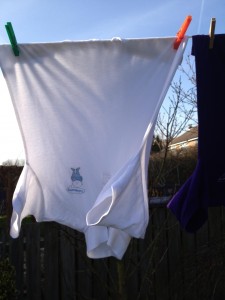Cary Grant’s Secret or How to develop children’s vocabulary for free!
Date posted: Sunday 24th February 2013

My Granny once gave me three pieces of useful advice: always carry a handkerchief, wear clean pants every day in case you fall down in the street and end up in hospital, and never trust a man who changes his name. Granny was ‘Old School’, and this post is about two of those nuggets.
Cary Grant, AKA Archie Leach, and star of such classics as North By Northwest, and To Catch a Thief, once confided in an interview that he preferred to wear women’s silk knickers. The reason he gave was that when he was staying in hotels knickers, or panties, as they are known stateside, were easier to wash in the sink and dried quickly: ready to wear the next day. You couldn’t make it up. But then Cary knew what he was doing. Or at least he thought he did, because after that revelation he appeared in Bringing Up Baby wearing Katherine Hepburn’s frilly dressing gown, and in a truly bizarre scene in Charade he took a shower dressed in his suit (and it wasn’t his birthday suit either). One Hollywood wag quipped, ‘These days Cary doesn’t need to act: he just plays himself.’
Where is this going? Well it’s all about how we can increase children’s vocabulary. When I was leading the Every Child a Talker (ECaT) project, I was convinced that there was a huge need to improve children’s vocabulary. Many children across the UK were starting school with limited language skills, and their limited vocabulary in particular was a key factor linked to later educational failure. So I was on a mission to increase all children’s ‘Word Power’.
The scope of the problem was brought home to me when I was sharing a funny story called How Do I Put It On? It’s a simple tale of a teddy bear who doesn’t know how to get dressed. I would start off with a small group of children, two almost life-size boy and girl puppets and a pile of children’s clothes. We would sort the clothes into what the children thought was right for boys and girls to wear, and take turns to dress the puppets. The children, aged three and a half, had no problem in deciding in what order the puppets should put their clothes on, and they could see the funny side of me trying to put the boy’s socks on after he had put on his boots. But there was outrage when I suggested that the boy puppet put on a pair of knickers. Outrage from the girls, that is-the boys didn’t bat an eyelid. Were their parents from the Cary Grant school of getting dressed, or was there something else going on?
When I discussed this with my colleagues I realised that this was an indicator of the children’s lack of experience and vocabulary. The little boys just didn’t know that there were such things as knickers, and ‘pants’ was the word they used to describe all underwear. Well that is hardly surprising, you might say. But this was the tip of a much bigger iceberg of limited vocabulary development. Many children called all clothes covering their top halves a ‘top’: including jumpers, cardigans, fleeces and hoody tops. A little bit of earwigging revealed that many parents used the word ‘top’, as in, ‘Where’s your top? /Put your top on’ etc. Polo shirts, T-Shirts, and long-sleeved shirts were all referred to as ’shirts’. I also noticed that many of the staff’s use of vocabulary was similarly inexact.
I’m not bashing parents or practitioners here: we all know that when we are in a hurry we talk as simply as we can. No teacher preparing a group of children to go outside for playtime is going to say, “Right children, put on your coats, jackets, duffel coats, bomber jackets, boots, trainers, sandals, pumps, hats, balaclavas, berets etc. etc.” However it seems to me that if we want to increase children’s vocabulary, all we have to do is to talk accurately to them during everyday activities. So once I have said to the whole group, “Everybody put your coats on,” I will then talk to individual children about what they are wearing: “That’s a nice jacket/ Shall I help you fasten the toggles on your duffel coat? / Those are very smart trainers/ I like your T-shirt/ Have you noticed my new polo shirt?” etc. etc. Children sometimes argue with me; e.g. one little boy told me, “They are not toggles. My Mum calls them buttons.” To which I replied, “Sometimes things have different names. Mummy calls them buttons, and I call them toggles.”

Polo shirt or T-shirt? The answer, my friend, is blowin’ in the wind.
This is often all that is needed to give all children’s vocabulary a real boost. Some settings have taken things a stage further: by putting up displays to remind children and adults that every object has a name, and some have two or even three. One nursery had a display on the wall in the home corner, with photos of key objects that children regularly play with, and captions beneath them; e.g. saucepan/frying pan, cup/mug, plate/saucer, washing up bowl and washing up brush/scourer. Some items are given different names in families; e.g. tea towel/drying up cloth. This can be discussed with the children, so they can understand each other and learn about local variations. It was only recently, for example, that I learned that what I call spring onions are referred to as scallions in Northern Ireland, and what to me is a swede is known as a turnip in Scotland. In the USA trousers are called pants. This is all grist to the mill (whatever that means) for children’s vocabulary development.
One of my favourite displays was on the front of the children’s spare clothes cupboard in a neighbourhood nursery. Real items of children’s clothing had been stapled on the doors, with captions underneath, so everyone could talk accurately about what they needed: tights or knickers? Briefs or boxer shorts? T-Shirt or polo shirt?
This did make me wonder whether Cary Grant would have benefited from attending a setting that had been involved in the ECaT project. Occasionally I wonder whether Reg Dwight and Harry Webb would have become such famous singers if they hadn’t changed their names…
This post was written in a hotel room. In case you are wondering, I’m going to the launderette tomorrow.
How Do I Put It On? Is written by Shigeo Watanabe.
Let’s Get Talking! Exciting ways to help children with speech and language difficulties by Michael Jones & Jo Belsten is available from www.lawrenceeducational.co.uk
https://www.youtube.com/watch?v=j4xoxFrRA2Q
Sign up for Michael's weekly blog post by clicking here!
Interesting….I have been “told off” in the past for including words in my childrens’ songs that the children won’t know….but how can they learn them if we don’t use them?
PS What a very practical man Cary Grant was!
Ah Michael, you’re preaching to the converted I’m afraid. I well remember a child arriving in the reception class with hardly any speech. At home he simply pointed at the things he wanted and he was given them. The BVPS (is that still going?) indicated a vocabulary of a two year old.
My other recollection is of a Y3 child showing me a mark on his arm. I sympathised with him: “That’s a nasty bruise.”
“What’s a bruise?” he asked.
“The mark on your arm, it’s a bruise.”
“No it’s not,” he laughed, “it’s a poorly.”
To this eight year old, bruises, scrapes, grazes and presumably dislocations, breaks and a whole range of mangled (and potentially severed) limbs were ‘poorlies’.
The enrichment of vocabulary is a vital aspect of education and it needs to continue far beyond the Early Years setting.
Absolutely Michael. So much learning is to do with refinement as you describe.
On Cary Grant and language you will remember how he replied to an impertinent telegram ‘How old Cary Grant ?’ with ‘Old Cary Grant fine – how you ?’
Dear Michael, I very much enjoyed attending your evening The Quiet Child, and look forward to receiving more of your posts.
I, too, have 3-4yo boys remonstrating with me that they’re not wearing knickers, but pants – they are outraged for some reason at the idea of enlarging their vocab and some state that knickers are only for girls. Not on my watch, they’re not. Incidentally, a few weeks ago I found a jumper for a 4yo to wear as his mother hadn’t brought one in for him and it was a bit nippy outside. Knitted and striped blue and cream, it was rejected by her with “He’s not wearing a girl’s top!”
We have “Muddy Trousers” for wearing in the garden when needed, and if all the blue ones are being worn, the rest of the boys (we have c.80% boys) are left with the pink ones (50%). Our owner bought them like this to encourage the children to try to disassociate colours with strict gender preferences. Most of our girls come in most days dressed head to toe in pink, including socks and underwear, while the boys are always very triumphant to tell us that they have Ben10 underwear and Batman t-shirts, say, on. Sigh. Small children are doing their best to find out about the world and fit into it; is it really helpful to commodify, colour-sort, and divide them like this when they are going to swallow it all wholesale?